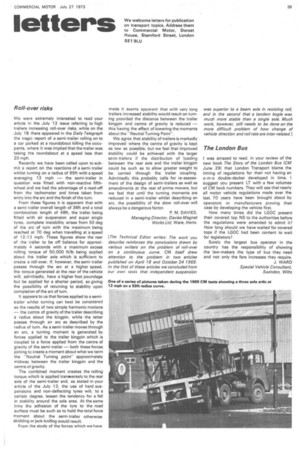letters
Page 61

If you've noticed an error in this article please click here to report it so we can fix it.
Roll-over risks
We were extremely interested to read your article in the July 13 issue referring to high trailers increasing roll-over risks, while on the July 18 there appeared in the Daily Telegraph the tragic report of a semi-trailer rolling on to a car parked at a roundabout killing the occupants, where it was implied that the trailer was taking the roundabout at a speed less than 20 mph.
Recently we have been called upon to submit a report on the reactions of a semi-trailer whilst turning on a radius of 65ft with a speed averaging 13 mph — the semi-trailer in question was fitted with non-reactive fifthwheel and we had the advantage of a read-off from the tachometer and times taken from entry into the arc and the finish of the turn.
From these figures it is apparent that with a semi-trailer overall length of 36ft and a total combination length of 48ft, the trailer being fitted with air suspension and super single tyres, complete instability arises from 50 deg of the arc of turn with the maximum being reached at 70 deg when travelling at a speed of 12-13 mph. These figures show the rear of the trailer to be off balance for approximately 4 seconds with a maximum excess rolling torque of 50,000 ft/lb being applied about the trailer axle which is sufficient to create a roll-over. lf, however, the semi-trailer passes through the arc at a higher speed, the torque generated at the rear of the vehicle will, admittedly, have a higher foot poundage but be applied for a shorter period, so giving the possibility of returning to stability upon completion of the arc of turn.
It appears to us that forces applied to a semitrailer whilst turning can best be considered as the results of two simple harmonic motions — the centre of gravity of the trailer describing a radius about the kingpin, while the latter passes through an arc as described by the radius of turn. As a semi-trailer moves through an arc, a turning moment is generated by forces applied to the trailer kingpin which is coupled to a force applied from the centre of gravity of the semi-trailer — both these forces joining to create a moment about what we term the "Neutral Turning point" approximately midway between the trailer kingpin and the centre of gravity.
The combined moment creates the rolling torque which is applied transversely to the rear axle of the semi-trailer and, as stated in your article of the July 13, the use of hard suspensions and non-deflecting tyres will, to a certain degree, lessen the tendency for a fall in stability around the axle area. At the same time the adhesion of the tyre to the road surface must be such as to hold the total force moment about the semi-trailer otherwise skidding or jack-knifing would result.
From the study of the forces which we have made it seems apparent that with very long trailers increased stability would result on turning provided the distance between the trailer kingpin and centre of gravity is reduced — this having the effect of lowering the moments about the "Neutral Turning Point".
We agree that stability of trailers is markedly improved where the centre of gravity is kept as low as possible, but we feel that improved stability could be achieved with the larger semi-trailers if the distribution of loading between the rear axle and the trailer kingpin could be such as to allow greater weight to be carried through the trailer coupling. Admittedly this probably calls for re-assessment of the design of semi-trailers as well as amendments at the rear of prime movers, but we feel that until the turning moments are reduced in a semi-trailer whilst describing an arc, the possibility of the slow roll-over will always be a dangerous factor, P. M. DAVIES, Managing Director, Davies Magnet Works Ltd, Ware, Herts.
[The Technical Editor writes: The work you describe reinforces the conclusions drawn by various writers on the problem of roll-over on a continuous curve. CM itself drew attention to the problem in two articles published on April 18 and October 24 1969. In the first of these articles we concluded from Our Own tests that independent suspension
The London Bus
I was amazed to read, in your review of the new book The Story of the London Bus (CM June 29) that London Transport blame the timing of regulations for their not having an o-m-o double-decker developed in time. I suggest you present LT with a few volumes of CM back numbers. They will see that nearly all motor vehicle regulations made over the last 70 years have been brought about by operators or manufacturers proving their case by developing the vehicle first.
How many times did the LGOC present their covered top NS to the authorities before the regulations were amended to admit it? How long should we have waited for covered tops if the LGOC had been content to wait for legislators?
Surely the largest bus operator in the country has the responsibility of showing the law-makers the type of bus they need and not only the fare increases they require. J. WARD Special Vehicle Consultant, Swindon, Wilts
























































































































































